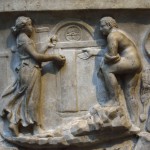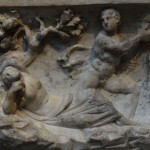Text
Awan, Heather, “Roman Sarcophagi, In Beilbrunn Timeline of Art History,” The Metropolitan Museum of Art. Accessed December 16, 2015. http://www.metmuseum.org/toah/hd/rsar/hd_rsar.htm
Koortbojian, Michael, Myth, Meaning, and Memory on Roman Sarcophagi (University of California Press E-Books Collection, 1995).
Lehmann-Hartleben , Karl and Erling Olsen, Dionysiac Sarcophagi in Baltimore (Baltimore: Institute of Fine Arts, New York University, 1942).
Friedrich Matz, “An Endymion Sarcophagus Rediscovered,” The Metropolitan Museum of Art Bulletin 15 (1957)
McCann, Anna Marguerite, Roman Sarcophagi in the Metropolitan Museum of Art (The Metropolitan Museum of Art, New York, 1978).
“Sarcophagus Depicting the Birth of Dionysus.” The Walters Art Museum. Accessed November 30, 2015. http://art.thewalters.org/detail/16574/sarcophagus-depicting-the-birth-of-dionysus/
“Sarcophagus with Dionysus and Ariadne.” The Walters Art Museum. Accessed December 1, 2015. http://art.thewalters.org/detail/23618/sarcophagus-with-dionysus-and-ariadne/
“Sarcophagus with the Triumph of Dionysus.” The Walters Art Museum. Accessed November 30, 2015. http://art.thewalters.org/detail/33305/sarcophagus-with-the-triumph-of-dionysus/
Zanker, Paul and Bjon Ewald, Living with Myths: The Imagery of Roman Sarcophagi, trans. Julia Slater (Oxford University Press, 2012).
Zanker, Paul “Reading images without texts on Roman sarcophagi,” Res 61/62 (2012) 169-177.
Images
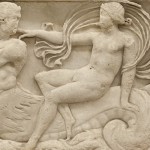 Figure 1
Figure 1
“Sarcophagus with sea nymphs and sea centaurs, Unknown maker, Roman, ca. 165-180 AD.” The Mead Museum. Accessed December 17, 2015. https://rotherwasroom.sites.amherst.edu/2015/04/23/on-view/
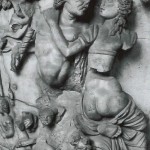 Figure 2
Figure 2
“Nereid embracing Triton partner, second quarter of third century AD” In Living with Myths: The Imagery of Roman Sarcophagi, by Paul Zanker and Bjon Ewald, Illustration 104. Oxford University Press, 2012.
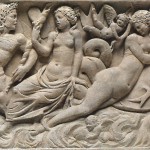 Figure 3
Figure 3
“A Nereid rides alongside a sea bull and fondles him, second quarter of third century AD” In Living with Myths: The Imagery of Roman Sarcophagi, by Paul Zanker and Bjon Ewald, Illustration 106. Oxford University Press, 2012.
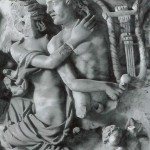 Figure 4
Figure 4
“Nereid embracing Triton partner with musical instrument, second quarter of third century AD” In Living with Myths: The Imagery of Roman Sarcophagi, by Paul Zanker and Bjon Ewald, Illustration 105. Oxford University Press, 2012.
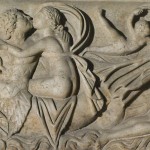 Figure 5
Figure 5
“A pair kissing, circa 150 AD,” In Living with Myths: The Imagery of Roman Sarcophagi, by Paul Zanker and Bjon Ewald, Illustration 107. Oxford University Press, 2012.
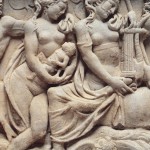 Figure 6
Figure 6
“Nereids and sea centaurs in cosy family bliss, second half of third century AD,” In Living with Myths: The Imagery of Roman Sarcophagi, by Paul Zanker and Bjon Ewald, Detail of Illustration 95. Oxford University Press, 2012.
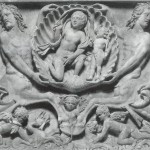 Figure 7
Figure 7
“Crouching portrait of deceased, early third century AD,” In Living with Myths: The Imagery of Roman Sarcophagi, by Paul Zanker and Bjon Ewald, Illustration 110. Oxford University Press, 2012.
 Figure 8
Figure 8
“Two older sea centaurs with their Nereids hold a shell with the portraits (not completed) of a married couple, first half of third century AD,” In Living with Myths: The Imagery of Roman Sarcophagi, by Paul Zanker and Bjon Ewald, Illustration 111. Oxford University Press, 2012.
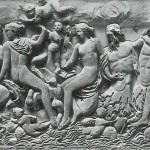 Figure 9
Figure 9
“Nereid and Triton sarcophagus, circa middle of the second century AD” In Living with Myths: The Imagery of Roman Sarcophagi, by Paul Zanker and Bjon Ewald, Illustration 96. Oxford University Press, 2012.
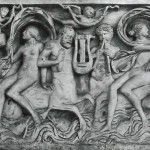 Figure 10
Figure 10
“Tritons playing musical instruments sarcophagus, middle of second century AD” In Living with Myths: The Imagery of Roman Sarcophagi, by Paul Zanker and Bjon Ewald, Illustration 99. Oxford University Press, 2012.
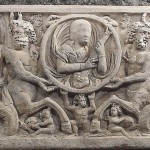 Figure 11
Figure 11
“The portrait of the deceased woman is presented by two Tritons, circa 240 AD,” In Living with Myths: The Imagery of Roman Sarcophagi, by Paul Zanker and Bjon Ewald, Illustration 100. Oxford University Press, 2012.
 Figure 12
Figure 12
“A Dionysiac feast held by night, circa 150 AD” In Living with Myths: The Imagery of Roman Sarcophagi, by Paul Zanker and Bjon Ewald, Illustration 128. Oxford University Press, 2012.
 Figure 13
Figure 13
“A drunken Dionysus supported by satyr,” In Living with Myths: The Imagery of Roman Sarcophagi, by Paul Zanker and Bjon Ewald, Illustration 122. Oxford University Press, 2012.
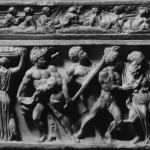 Figure 14
Figure 14
“Sarcophagus Depicting the Birth of Dionysus.” The Walters Art Museum. Accessed November 30, 2015. http://art.thewalters.org/detail/16574/sarcophagus-depicting-the-birth-of-dionysus/
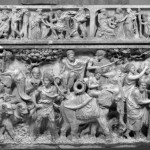 Figure 15
Figure 15
“Sarcophagus with the Triumph of Dionysus.” The Walters Art Museum. Accessed November 30, 2015. http://art.thewalters.org/detail/33305/sarcophagus-with-the-triumph-of-dionysus/
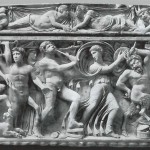 Figure 16
Figure 16
“Pair of centaurs pull drunk Dionysus among celebration, circa 160-70 AD,” In Living with Myths: The Imagery of Roman Sarcophagi, by Paul Zanker and Bjon Ewald, Illustration 119. Oxford University Press, 2012.
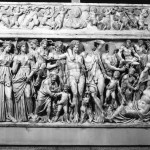 Figure 17
Figure 17
“Sarcophagus with Dionysus and Ariadne.” The Walters Art Museum. Accessed December 1, 2015. http://art.thewalters.org/detail/23618/sarcophagus-with-dionysus-and-ariadne/
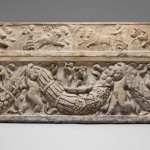 Figure 18
Figure 18
“Marble sarcophagus with garlands and the myth of Theseus and Ariadne, circa 130–150 AD,” The Metropolitan Museum of Art, December 16, 2015. http://www.metmuseum.org/toah/works-of-art/90.12a,b.
Figure 18, Detail A-C
Lankiewicz, Emily, “Detail of Marble sarcophagus with garlands and the myth of Theseus and Ariadne, circa 130–150 AD, at the Met” November 11, 2015.
 Figure 19
Figure 19
“Sarcophagus with the Myth of Dionysos and Ariadne” The Louvre Museum. Accessed December 17, 2015. http://www.louvre.fr/en/oeuvre-notices/sarcophagus-myth-dionysos-and-ariadne
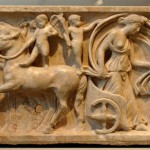 Figure 20
Figure 20
“Sarcophagus with myth of Endymion, second century, New York, Metropolitan Museum,” Early Christian Art and Architecture. Accessed December 17, 2015. https://www.oneonta.edu/faculty/farberas/arth/smarthistory/early_christianity_smarthistory.html
 Figure 21
Figure 21
“Marble sarcophagus with the myth of Selene and Endymion” The Metropolitan Museum of Art. Accessed December 17, 2015. http://www.metmuseum.org/collection/the-collection-online/search/254590
 Figure 22
Figure 22
“Sarcophagus with the Legend of Selene and Endymion” The Louvre Museum. Accessed December 17, 2015. http://www.louvre.fr/en/oeuvre-notices/sarcophagus-legend-selene-and-endymion
 Figure 22
Figure 22
Harrsch, Mary “Funerary relief entitled The Death of Meleager Roman 2nd century CE Marble,” Flickr. Accessed December 19, 2015. https://www.flickr.com/photos/mharrsch/4277001503/
